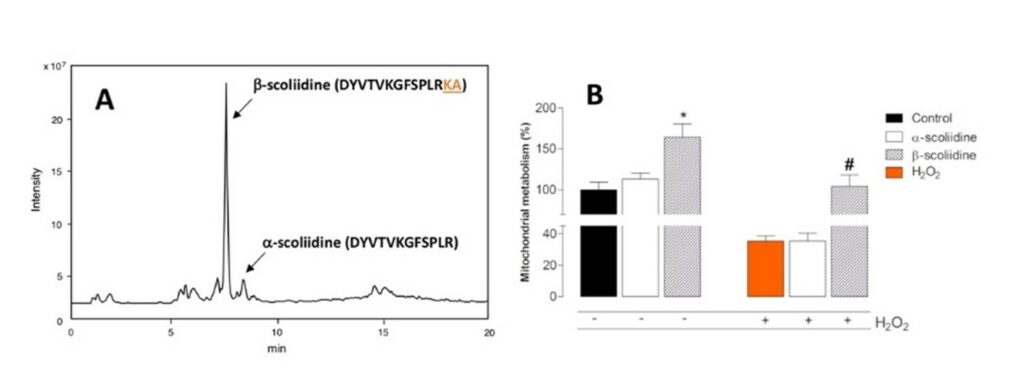Carlos Alberto-Silva, Professor, Experimental Morphophysiology Laboratory, Federal University of ABC (UFABC), São Bernardo do Campo, SP, Brazil.
Fernanda Calheta Vieira Portaro, Scientific Researcher, Immunochemistry Laboratory, Butantan Institute, São Paulo, SP, Brazil.
Katsuhiro Konno, Professor, Institute of Natural Medicine, University of Toyama, Toyama, Toyama 930-0194, Japan.
 Arthropod venoms are a rich source of bioactive molecules, and some of them may be useful for medical and agricultural applications. In this scenario, knowledge of the components present in solitary wasp venoms may help in identifying molecules of biotechnological interest, which may become drugs or prototypes for the development of new drugs. Previous studies supervised by Dr. Katsuhiro Konno from the University of Toyama, Japan, have demonstrated that solitary wasp venoms contain not only neuroactive substances as major components, but also a variety of bioactive peptides such as bradykinin-related and antimicrobial peptides.
Arthropod venoms are a rich source of bioactive molecules, and some of them may be useful for medical and agricultural applications. In this scenario, knowledge of the components present in solitary wasp venoms may help in identifying molecules of biotechnological interest, which may become drugs or prototypes for the development of new drugs. Previous studies supervised by Dr. Katsuhiro Konno from the University of Toyama, Japan, have demonstrated that solitary wasp venoms contain not only neuroactive substances as major components, but also a variety of bioactive peptides such as bradykinin-related and antimicrobial peptides.
Recently, we focused on the Japanese species of the solitary scoliid wasp, Scolia decorata ventralis, belonging to Scoliidae family and Scolia genus. The venom content was investigated through a comprehensive analysis using LC-MS and two peptides were determined as its main components. Using synthetic peptides, homologous to the natural ones, the biological activities were evaluated. This study “Novel neuroprotective peptides in the venom of the solitary scoliid wasp Scolia decorata ventralis” was performed in collaboration with Dr. Fernanda Calheita Vieira Portaro from the Butantan Institute, Brazil and Dr. Carlos Alberto-Silva, from the Federal University of ABC, Brazil, and published in the Journal of Venomous Animals and Toxins including Tropical Diseases (vol. 27; DOI: 10.1590/1678-9199-JVATITD-2020-0171).

Figure 1. (A) Total ion current profile from LC-ESI-MS of crude venom extracts and identification of α-scoliidine and β-scoliidine peptides. (B) Neuroprotective property of α-scoliidine or β-scoliidine on mitochondrial metabolism of the PC12 cells against oxidative stress-induced neurotoxicity, an in vitro model to study neurodegeneration diseases. Image: ALBERTO-SILVA, C. A., et al.
Online mass fingerprinting revealed that the venom contains 123 components, and the MS/MS analysis resulted in 33 full peptide sequences. The two main peptides (Figure 1A), α-scoliidine (DYVTVKGFSPLR) and β-scoliidine (DYVTVKGFSPLRKA), present homology with the bradykinin C-terminal. Despite this, both peptides did not behave as substrates or inhibitors of angiotensin-converting enzyme or human neprilysin, indicating that they do not interact with these metallopeptidases. β-scoliidine, but not α-scoliidine, showed protective effects against H2O2-induced toxicity in a neuronal cell line (PC12 cells) (Figure 1B), a cellular stress model to study different neurodegenerative diseases. Interestingly, these data indicate that neuroprotective effects of β-scoliidine could be explained by the increased cell proliferation in the used model, since we reported that this peptide increased the PC12 cell viability 24 hours after treatment. Despite that, more studies are required to better clarify the mechanism underlying how β-scoliidine induces cell proliferation, and its relation to the neuroprotective effect.
In summary, in this work, α-scoliidine and β-scoliidine were identified as major components from comprehensive LC-MS and MS/MS analyses from the Scolia decorate ventralis venom. Despite the high similarity between them, β-scoliidine, which has the extension of the KA dipeptide at the C-terminal in comparison with α-scoliidine, showed effective cytoprotetion against oxidative stress in neuronal cells, and this is the first report of solitary wasp venom peptides showing neuroprotective activity.
To read the article, acess
ALBERTO-SILVA, C. A., et al. Novel neuroprotective peptides in the venom of the solitary scoliid wasp Scolia decorata ventralis. J. Venom. Anim. Toxins incl. Trop. Dis [online]. 2021, vol.27: e20200171, ISSN: 1678-9199 [viewed 05 July 2021]. https://doi.org/10.1590/1678-9199-JVATITD-2020-0171. Available from: http://ref.scielo.org/xn8d78
External links
Facebook – Journal of Venomous Animals and Toxins including Tropical Diseases: https://www.facebook.com/JVATiTD
Journal of Venomous Animals and Toxins including Tropical Diseases: http://www.jvat.org/
Journal of Venomous Animals and Toxins including Tropical Diseases – JVATITD: http://www.scielo.br/jvatitd
Twitter – Journal of Venomous Animals and Toxins including Tropical Diseases: https://twitter.com/JVATiTD
Como citar este post [ISO 690/2010]:














Recent Comments